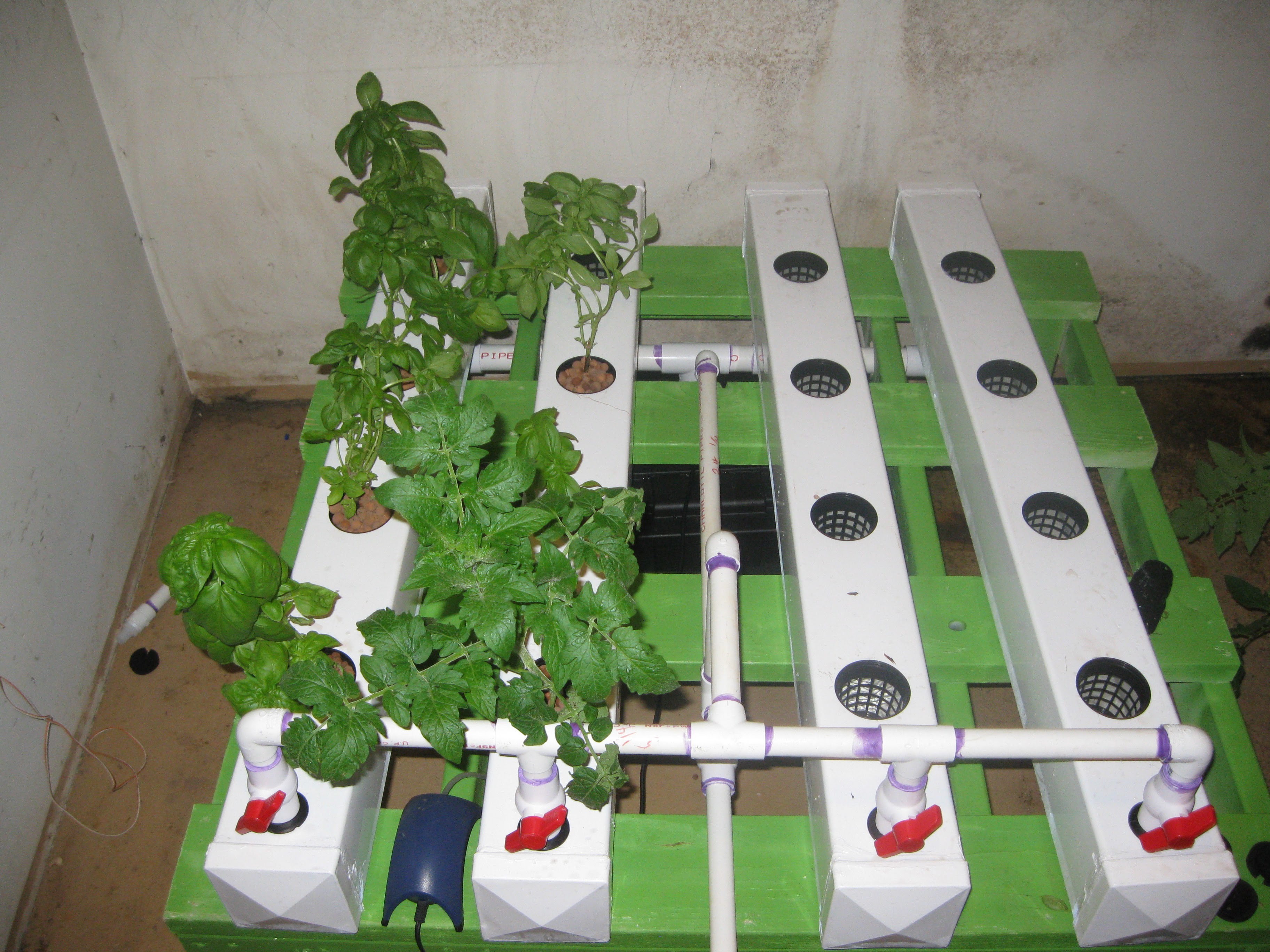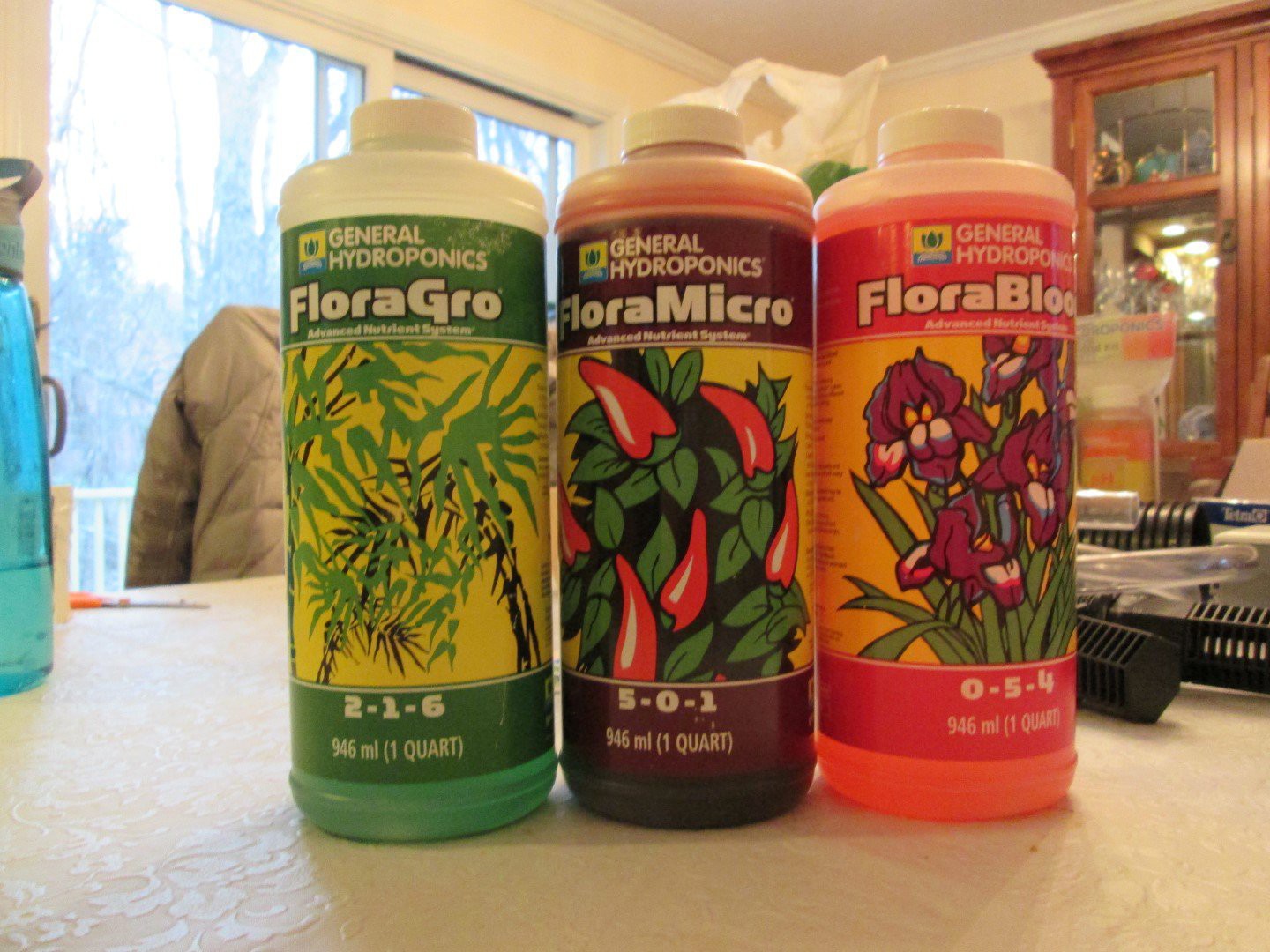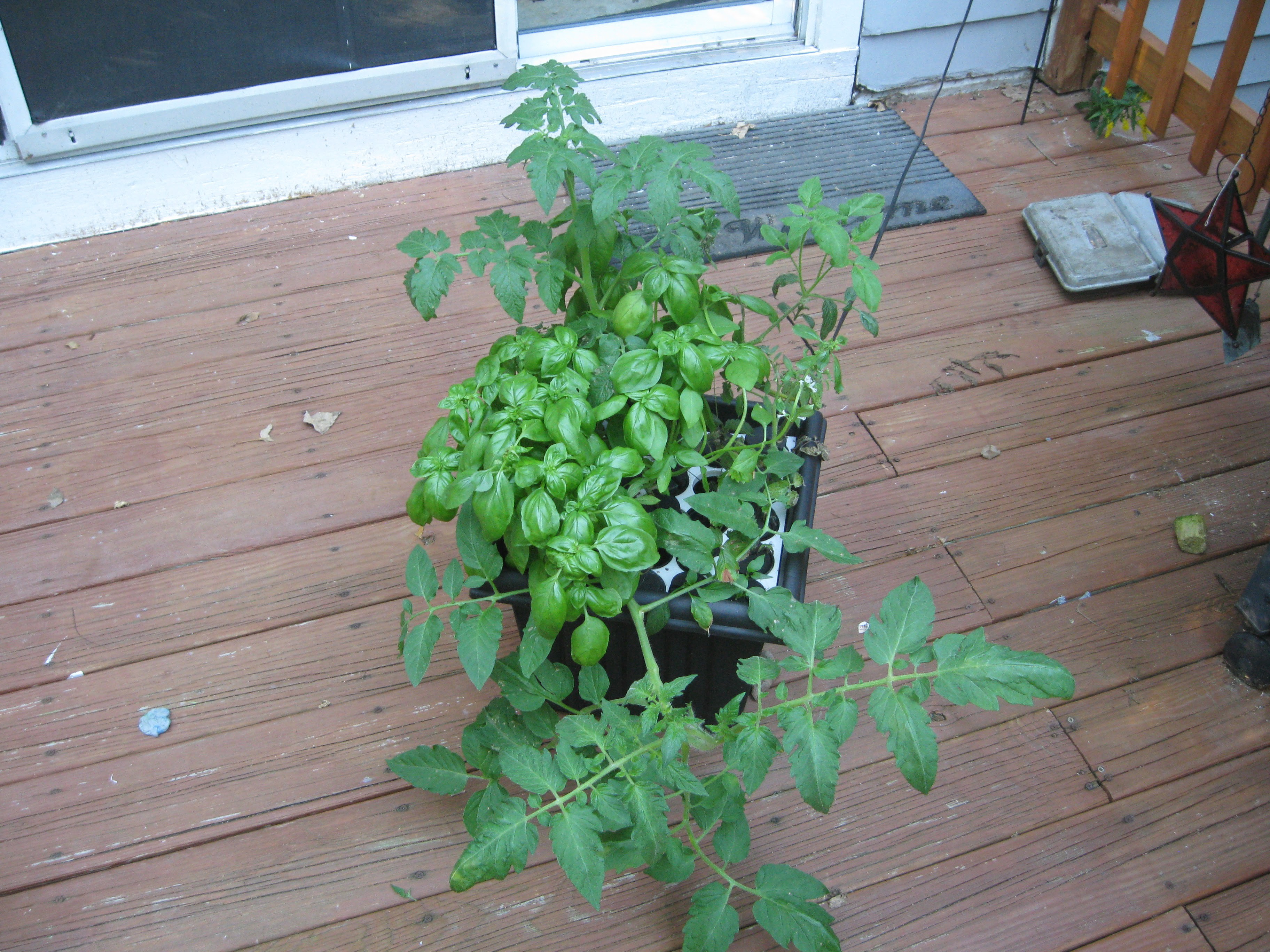NOTE: Old Version of Project Details Found At: https://docs.google.com/document/d/15zJV8n_mmsi-2uBfyr8qPgzABSB5OiX3CfhfoaBXDTw/edit?usp=sharing
Abstract
HydroPWNics is an open source intelligent, connected, and autonomous hydroponic and dirt based garden control system. The goal is to design and develop an open source garden control system to facilitate sustainable independent farming. Existing systems for this purpose are mostly proprietary and expensive, HydroPWNics aims to be a fully open source and cost effective solution for everyone!
Overview
More specifically HydroPWNics is the system of hardware and software designed to control and monitor hydroponic gardens. The goal of such a system is to create a precisely controlled automated hydroponic garden. The benefit of such a garden would be autonomous food production, self-sustainability, and conserve water as a resource. The system consists of custom electronics and software integrated with and builtd on top of the already existing Neuron Robotics development kit. Hardware consists of the Neuron Robotics DyIO module, the HydroPWNics modules, and a Beaglebone Green. The DyIO is used in the AC power control box subsystem. The HydroPWNics modules are used for wireless plant and environmental sensing, and the Beaglebone Green runs the Java application directing all the hardware. The software consists of a Java application running on the Beaglebone Green for controlling the garden and a webui/website for viewing plant data and controlling the garden remotely. The Java application is written in the Neuron Robotics SDK and the HydroPWNics API, this application is what controls the garden, directing the hardware modules (DyIO, HydroPWNics modules) and sending plant data to the cloud (http://www.vivaplanet.io/).
Problem
HydroPWNics was started with the idea of creating an autonomous hydroponic garden. The purpose of such a garden would be for the autonomous and ultra-efficient production of healthy food produce. Modern human beings have busy schedules, may lack the expertise for agriculture, or be in a location that makes it difficult. HydroPWNics aims to be a complete open source autonomous hydroponics garden using the nutrient film technique method to save water. Developing nations could possibly make use of such a system to maximize food production and save huge on fresh water, a scare resource in some nations. Thought not initially, HydroPWNics will evolve into a solar powered system, further extending its efficiency and making it more energy friendly. By virtue of being open source HydroPWNics and every subsystem it incorporates is available to anyone everywhere. Additionally the basic components of the system are designed from parts easily source-able at hardware stores aside from the electronics.
Detailed Breakdown of The Whole System
Electronics:
HydroPWNics Cape - Beaglebone Green Cape
The HydroPWNics Cape turns a Beaglebone Green (or any Beaglebone really) into a base station and system controller for HydroPWNics. On board there will be two WiFi modules, one module will be for connecting the Beaglebone to the internet via the home WiFi network the other module will be for creating an adhoc network for connecting to SunLeaf modules. Also on board there will be power management circuitry to run the whole system off a battery if power is lost , a set of MOSFETs for relay control, and a RepRap discount display connector (hello incorporating existing open source tech ).

Specs:
- (2x) WiFi Module
- (4x) MOSFETs for Controlling Solidstate Relays
- RepRap Discount Display port, for external control and data display
- Power management system for battery operation failsafe mode
Sensors and Sensing
SunLeaf Module
Sensor interfacing will be accomplished with SunLeaf module, a project born out of HydroPWNics for general purpose sensing applications. For use in the HydroPWNics system the SunLeaf modules will be flashed with a custom firmware and configured to run off a power supply feed rather than a solar panel, the SunLeaf modules used for HydroPWNics will also have the voltage regulators upgraded to a 1.5A capable regulator for handling more power hungry peripherals. Learn more about the SunLeaf project at its own page: https://hackaday.io/project/10457-sunleaf
Environmental Monitoring
For environmental monitoring of the garden temperature, humidity, and light will be sensed/monitored. For sensing humidity and temperature the Adafruit HTU21D-F sensor will be used. The HTU21D-F interfaces over I2C and provides temperature and humidity data. Form optimal sensing the garden will be divided into 4 quadrants with a dedicated HTU21D-F in each quadrant. These HTU21D-F sensors will interface with the Module Hub via the Digital Sensor Module on one of the three Module Hub ports. For light sensing the Adafruit TSL2561 sensor will be used, it also communicates over I2C and will be interfaced with Module Hub in the same way. Again for optimal sensing the light sensors will be assigned to quadrants in the same way the temp/humidity sensors are.
pH Sensing
For pH sensing an aquarium pH probe will be used. The Probe will be read and data processed by a custom PCB that will interface via UART over a standard SeeedStudio Grove connector.
Custom LED Grow Light
HydroPWNics will be using custom made LED grow lights. LEDs are low power and energy efficient and run of DC voltage making conversion to solar power later easier. The lights are a simple design made of birch plywood, the LED strip is mounted inside and the PSU will be bolted on the end. The lights consist of two kinds of strip, a red, red, blue, LED grow strip and a mixed LED purple LED strip. The lights mostly consists of the red, red, blue variety, with only a few being of the mixed purple variety.
Specs
- DCDC 12V 30A LED Strip PSU (common PSU folks use)
- 5050 Red/Red/Blue LED Grow Strip 16FT (2x)
- 5050 Purple Mixed LED Strip 16FT
- Plywood frame
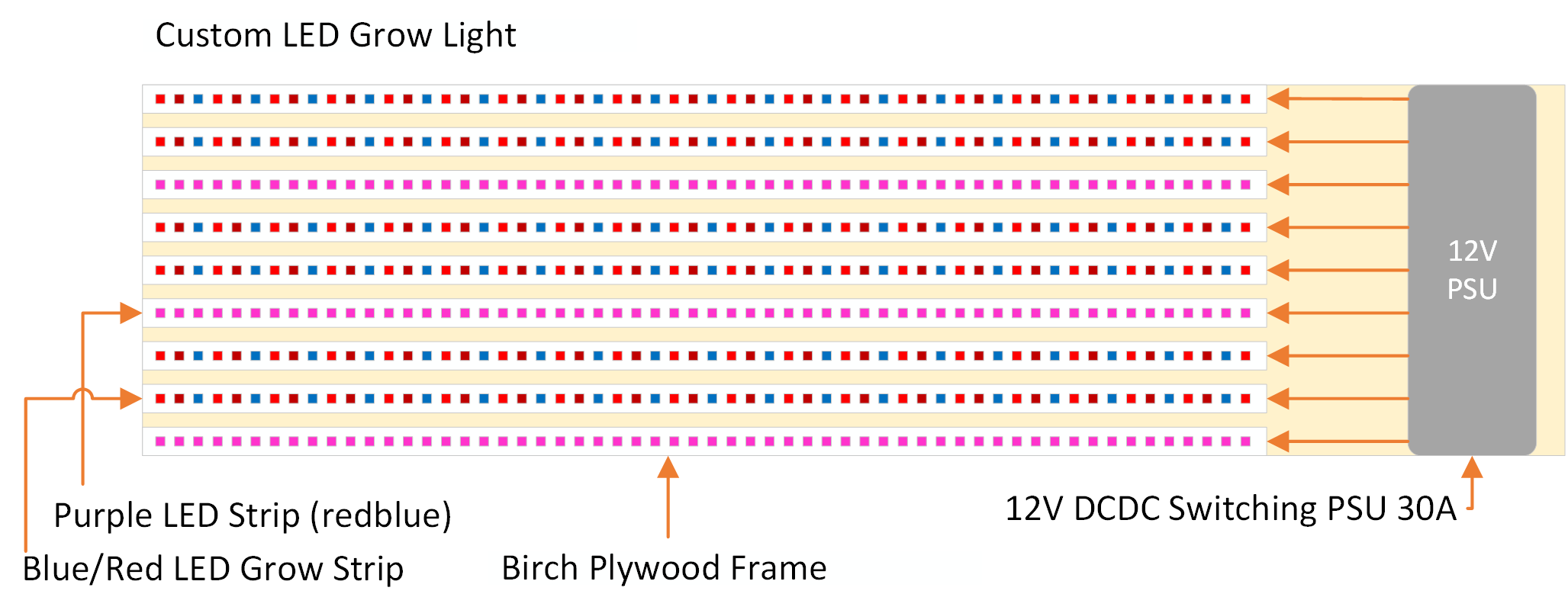
NFT Hydroponic Garden Grow System
As part of the HydroPWNics project a simple cost effective NFT hydroponic grow unit was designed and developed as a means to test the HydroPWNics garden control system.
Learn how you can build your own Here:
https://hackaday.io/project/7116-low-cost-nft-hydroponic-garden-under-200
Specs:
- 4 Rows made from 5X5" vinyl fence post
- 4 Plants per row in 3" netted pots, total of 16 plants in the unit.
- Water level of each row adjustable with valve
- 16 Gallon reservoir
- 158GPH Submersible Pump
- Cheap wooden frame
- Water aeration in reservoir
- Support up to 16 plants with capacity for large root systems
How it Works:
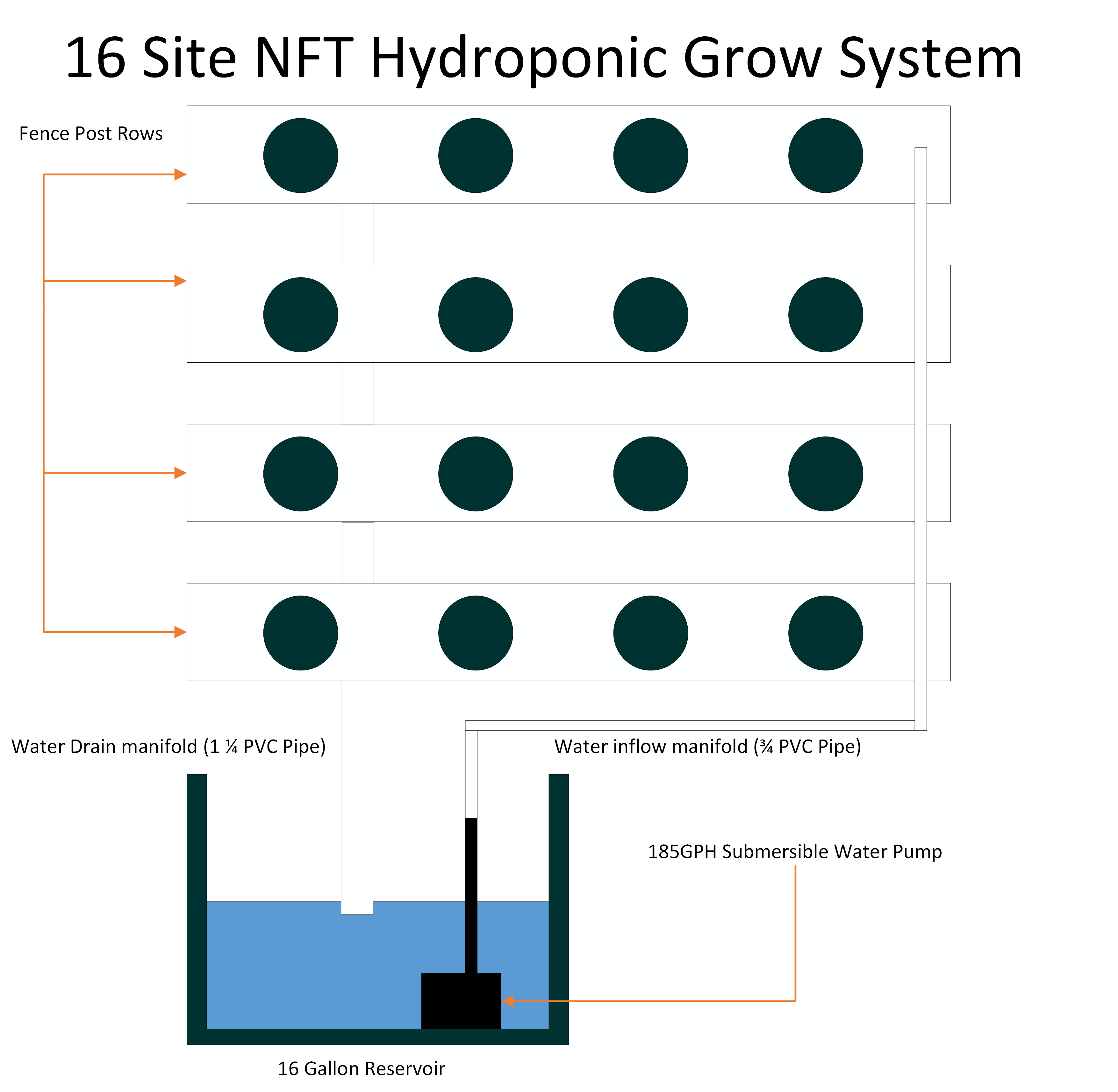
Completed Prototype:
Running and Plants transplanted (9/18/15)
Nutrients, Plants, Ecology, etc
For the hydroponics component of the project I am using General Hydroponics grow nutrients. They seem to be a popular brand among hydro enthusiasts. I ran a small shallow culture last summer with these nutrients and I was impressed at how fast the plants grew, I'm hoping to get the same experience but better now that I am building a proper unit. These nutrients come in very high concentrations so the 3 bottle set will last you quite a while.
General Hydroponics Nutrient Kit:
Included the kit are three different bottles of nutrient solution. The three kinds are FloraGro 2-1-6, FloraMicro 5-0-1, and FloraBloom 0-5-4. FloraGro is for structural and foliar growth, the numbers 2-1-6 refer to the composition of the solution in percents, 2 percent total nitrogen, 1 percent phosphate, 6 percent soluable potash. FloraGro can be used on its own or combined with either of the other two (or both) for nutrient solutions tailored to a specific style of plant. Typically when I do cuttings (cloning) or start seeds I use a solution made of just water and FloraGro 2-1-6, for example. (Learn more about the FloraGro here: http://generalhydroponics.com/site/gh/docs/prod_labels/floragro.pdf ) FloraMicro is for providing plants with nitrogen, potassium, and calcium, its usually combined with FloraGro and given to plants well past seedling phase. The 5-0-1 refers the composition of 5 percent total nitrogen, the 0 refers to micro nutrients (see bottle label http://generalhydroponics.com/site/gh/docs/prod_labels/floramicro.pdf) , and 1 percent total soluable potash. FloraBloom is for the later stages of the plants life, it provides the necessary nutrients for reproductive growth e.g flowering, fruits, and seed production. FloraBloom is added after the plants have advanced vegetative growth to begin the fruit developing process (Yay food!!!) . The 0-5-4 pertain to the composition of 5 percent available phosphate, 4 percent soluable potash, 1.5 percent magnesium, and 1 percent sulfur. (Learn more about the FLoraBloom http://generalhydroponics.com/site/gh/docs/prod_labels/florabloom.pdf ) In my experiment last year I mixed the solution for my plants based on the ratios recommended on the bottles of the nutrients, I will continue with that strategy to start but I would like to experiment with different combintations. Also long after the GH kit is used up (or sooner) I plan to evaluate Fox Farm branded nutrients as well as adding homemade compost based nutrient solution.
Special Thanks to General Hydroponics for having such informative labels for thier products, a lot of the information was derived from their labels and I feel like I should credit them here, all information on the nutrients was pulled from their PDF labels:
http://generalhydroponics.com/site/gh/docs/prod_labels/floragro.pdf
http://generalhydroponics.com/site/gh/docs/prod_labels/floramicro.pdf
http://generalhydroponics.com/site/gh/docs/prod_labels/florabloom.pdf
General Hydroponics Site:
http://generalhydroponics.com/site/index.php
Plants and Creating Plants
An important part of every garden no matter what kind are the plants that grow in the garden. There are a few ways to create plants for a hydroponic garden. You can start from seeds with special grow solution (time consuming), you can even order plants ready to go online, you can take cuttings of plants and clone/root them, and you can just take plants out of the ground clean off the roots and convert them over. I did a combination of pulling up plants and cuttings. To start the cuttings and convert the rooted plants over I got a small water culture rig. The setup is simple, just a pot with a water agitation pump and a simple foam core cutout to hold the pots. To keep the plants in the pots and have something for them to root into I used rockwool cubes. For plants I got a bunch of strawberries in a raised box in my backyard I just pulled the offshoot plants out of the dirty and rinsed them before stuffing them into rockwool cubes. I had some basil cuttings rooting on a window sill with just plain water in a glass I just took the rooted plants and put them in rockwool cubes and added them to the rig. The other plants are tomatoes and jalapeno peppers which are just cuttings stuck into rockwool, I'm hoping to root these.
In order to get these plants to root and have a lot o root growth I mixed up a solution for the water culture rig specifically for root grown and root boosting. Hopefully in a week or two these plants will be ready to load into the NFT Rig and be upgraded to bigger netted pots with terracotta stone growth media. For those interested, I am using General Hydroponics Rapid Start and Maxi Gro with this cloner, basically using the Maxi Gro as a booster for other sort of plant growth. More on the Rapid Start here: http://generalhydroponics.com/site/index.php/products/supplements/rapidstart/ More on Maxi Gro here: http://generalhydroponics.com/site/index.php/products/nutrients/maxi_series/maxigro/
Just before Transplant (9/18/15)
 AVR
AVR